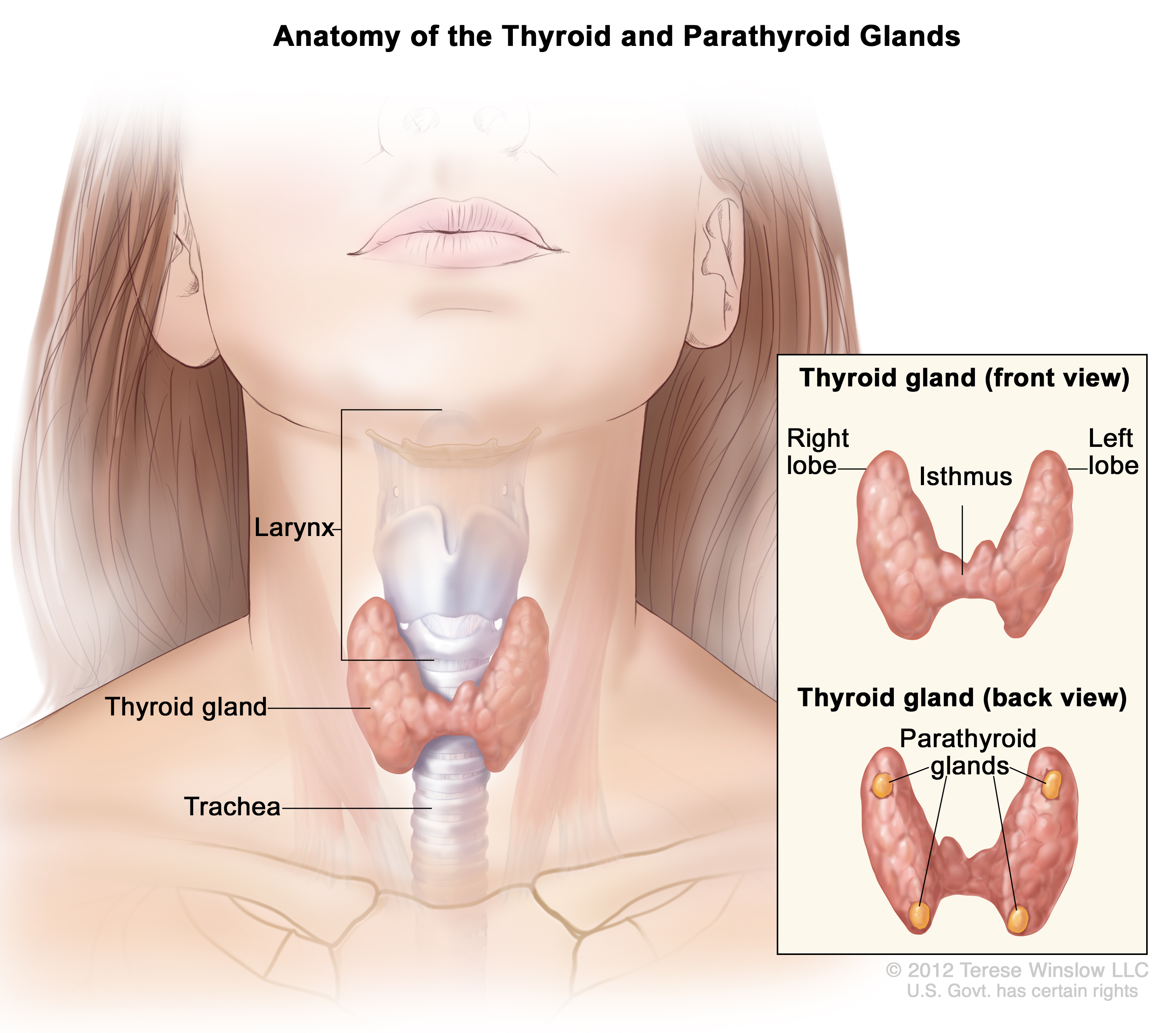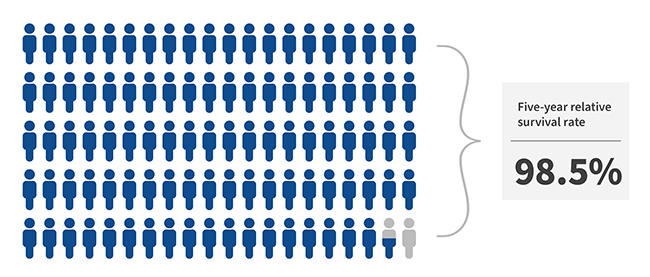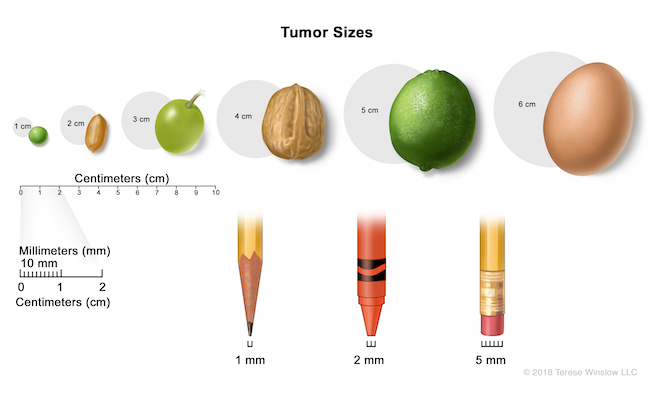Understanding Thyroid Cancer
Thyroid cancer is a group of distinct cancers that affect the thyroid, a gland at the base of the throat. With this cancer, it’s important to know:
- Thyroid nodules (bumps on the thyroid) are common but usually not cancer.
- Thyroid cancer has four main types. The most common types are usually highly curable.
- We also treat rare parathyroid cancer.

What is thyroid cancer?
The thyroid is a butterfly-shaped gland that straddles your windpipe (trachea) at the front of your neck. It has right and left lobes connected by a strip of tissue called the isthmus. It sits just below your Adam’s apple, the protective tissue that covers your voice box (larynx).
The thyroid produces hormones that:
- Regulate metabolism (how your body turns food into energy).
- Help control vital functions such as blood pressure, heart rate, body temperature and growth.
Cancer develops when thyroid cells grow out of control. The thyroid has two types of cells. Different cancers form on each kind:
- Follicular, which use iodine from the blood to regulate metabolism.
- C cells, which help control how your body uses calcium.
For patients
Call 503-494-2544 to:
- Request an appointment
- Seek a second opinion
- Ask questions
Location
Parking is free for patients and their visitors.
Center for Health & Healing Building 2
3485 S. Bond Ave.
Portland, OR 97239
Map and directions
Refer a patient
- Refer your patient to OHSU.
- Call 503-494-4567 to seek provider-to-provider advice.
Cancer clinical trials
Clinical trials allow patients to try a new test or treatment.
Read more
Learn more about OHSU Knight Cancer Institute treatments:
- Surgery
- Chemotherapy/medical oncology
- Radiation therapy
- Immunotherapy
- CAR T-cell therapy
- Targeted therapy
Learn about our expert care for children's thyroid conditions.
Who gets thyroid cancer?
About 44,000 people are diagnosed with thyroid cancer in the U.S. every year, according to the National Cancer Institute. Roughly 979,000 Americans are living with it.
The cause is unknown in most cases. Risk factors include:
- Age: Thyroid cancer occurs most often in people ages 25 to 65. Unlike other cancers, it often affects younger people.
- Gender: Women are about three times more likely to get thyroid cancer.
- Radiation exposure: People exposed to radiation to the head and neck as a child may be more likely to develop thyroid cancer. Radiation exposure from a nuclear power plant accident or nuclear weapon also increases risk.
- Health history: A history of an enlarged thyroid (goiter) could be a factor.
- Family history: A family history of thyroid disease and inherited genetic conditions, such as multiple endocrine neoplasia syndromes, increase risk. Most thyroid cancers are not related to genetic conditions, however. OHSU offers genetic counseling, risk assessment and testing for those who have or might have such a syndrome.
- Low iodine: People with iodine-poor diets, rare in the U.S., are more susceptible.
Survival rates

A key concept in understanding survival is five-year relative survival rate. This is the percentage of people who are alive five years after they were first diagnosed, compared to the general population. (It doesn’t count death from other causes.)
The five-year relative survival rate for thyroid cancer is 98.5%.
Certain types of thyroid cancer are difficult to treat, however, and have worse outcomes.
It's important to remember that statistics are averages and can’t predict the outcome for any one patient. These rates are also, by definition, based on treatments that were available five or more years ago.
Thyroid cancer symptoms
Thyroid cancer may not cause early symptoms, and other conditions may produce the same signs. See your doctor if any of these persist:
- A lump or swelling in the front of the neck
- Trouble breathing
- Trouble swallowing
- Pain when swallowing or pain in the front of the neck
- Hoarseness or other voice changes
- A constant cough without a cold
Screening
There is no screening test to find thyroid cancer in early stages. Changes in the thyroid’s size or shape can often be seen or felt, but they are usually caused by a hormone imbalance. Only about one in 10 thyroid nodules is cancerous, but your doctor may want to have one tested.
Thyroid cancer types
These are the main types. There are also many subtypes.
- Papillary: This type grows in the thyroid’s follicular cells, usually slowly. It’s more common in women. It often occurs before age 45. It accounts for about 80% of thyroid cancers and is usually curable.
- Follicular: This type forms in follicular cells, grows slowly and is highly treatable. About 10% to 15% of thyroid cancers are this type.
- Medullary: This type develops in the thyroid’s C cells and accounts for about 2% of thyroid cancers. It’s more difficult to treat.
- Anaplastic: In this aggressive type, cancer cells look quite different from normal thyroid cells. This type is difficult to treat and makes up about 2% of thyroid cancers.

Staging
Staging defines the extent of cancer to help doctors make treatment recommendations. This staging does not include medullary thyroid cancers. Age plays a role because researchers have reliable data on outcomes by age.
Younger than 55
Stage I: Cancer has not spread beyond lymph nodes.
Stage II: Cancer has spread to distant parts of the body.
55 and older
Stage I: The tumor is less than 4 centimeters and has not spread beyond the thyroid.
Stage II: One of the following is true:
- The tumor is less than 4 centimeters and has spread to nearby lymph nodes.
- The tumor is larger than 4 centimeters and has not spread beyond the thyroid.
- The tumor is larger than 4 centimeters, has invaded muscles next to the thyroid, and may or may not have spread to nearby lymph nodes.
Stage III: The tumor has spread beyond muscles to tissues such as the windpipe or voice box. It may or may not have spread to nearby lymph nodes.
Stage IV:
- Stage IVA: The tumor has invaded tissue surrounding the neck bones (vertebrae) or has surrounded major blood vessels.
- Stage IVB: Cancer has spread to distant parts of the body.
Parathyroid cancer
The parathyroids, pea-size glands that regulate calcium, are nested in the thyroid and can also develop cancer. This cancer is very rare, however, with fewer than 100 cases nationwide each year.
Symptoms
These cancers cause high calcium levels, leading to symptoms that can include:
- Fatigue
- Weakness
- Neck lump
- Frequent urination and dehydration
- Bone pain or fractures
Treatment
These cancers are difficult to treat. Surgical removal is usually the only option. At the Knight Cancer Institute, we use minimally invasive techniques, including video-assisted technology, for parathyroid surgery. Surgery is often done under local anesthesia, allowing patients to go home the same day.
Learn more
- Thyroid Cancer, National Cancer Institute
- Thyroid Cancer, U.S. National Library of Medicine
- Thyroid Cancer, American Cancer Society
- American Thyroid Association
- Thyroid Cancer Survivors’ Association
- Parathyroid Cancer Treatment, National Cancer Institute